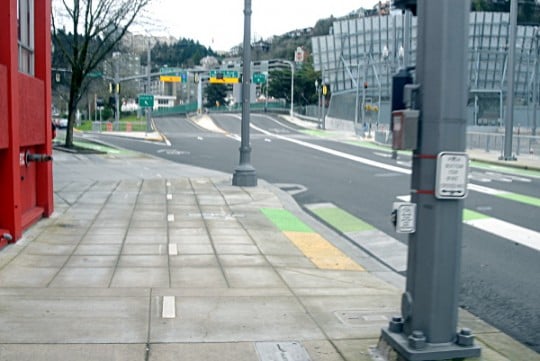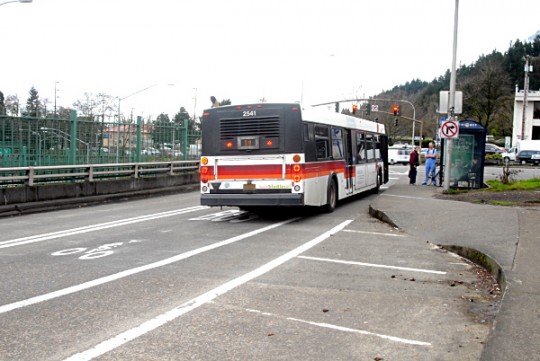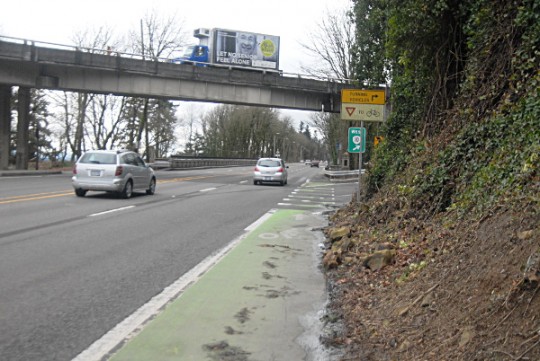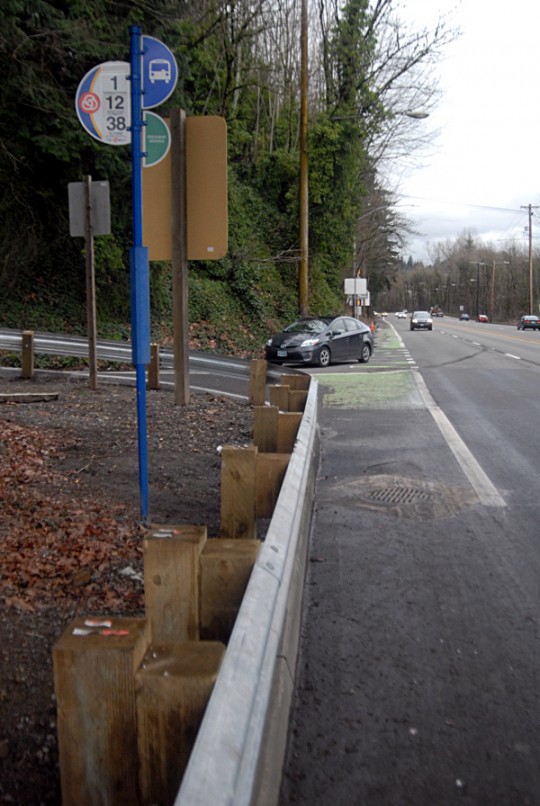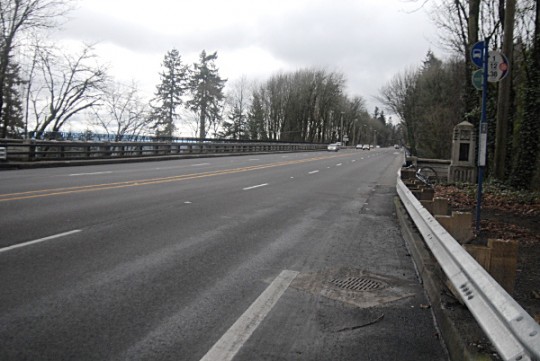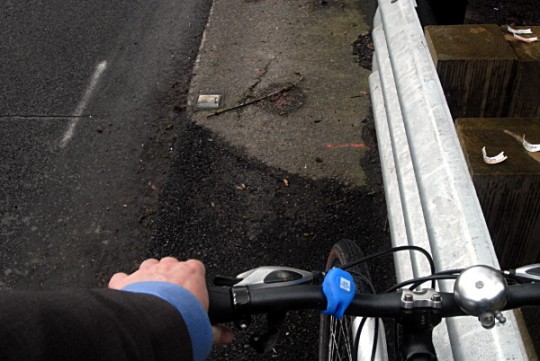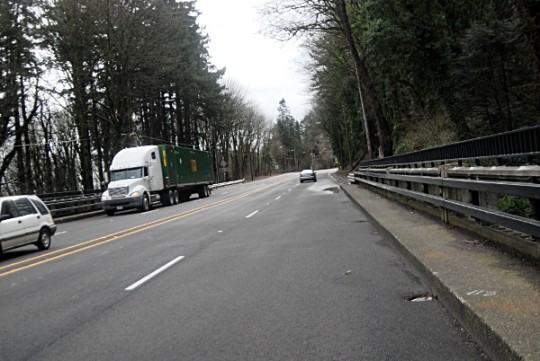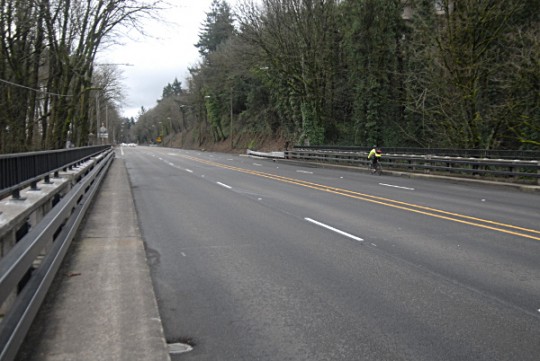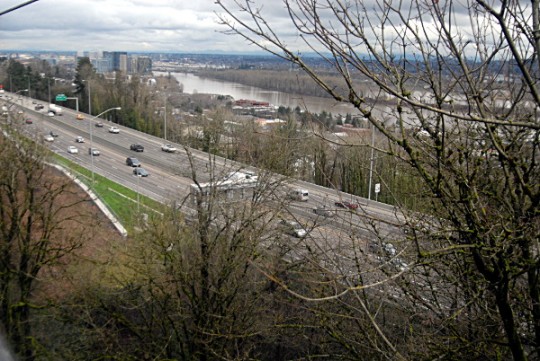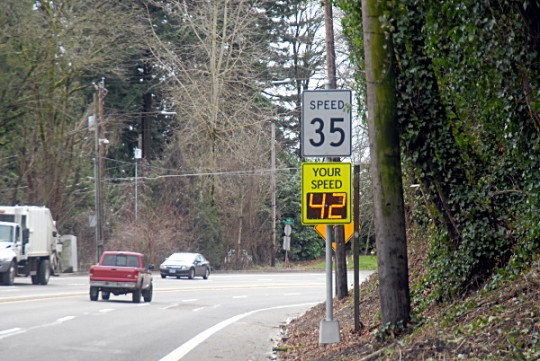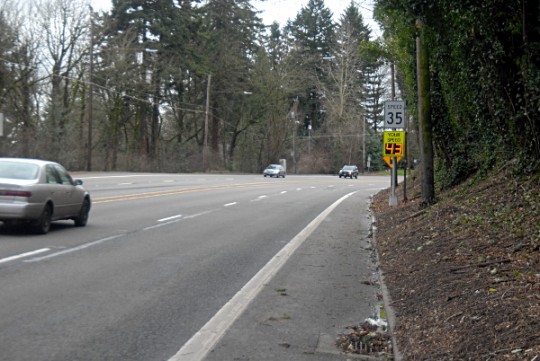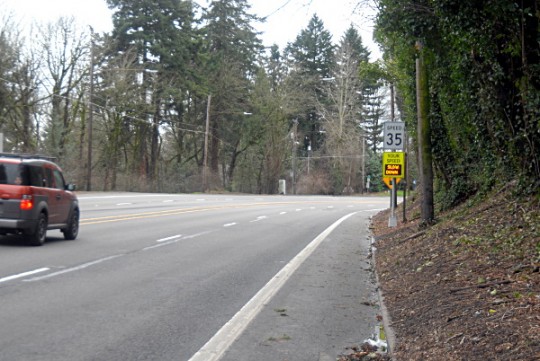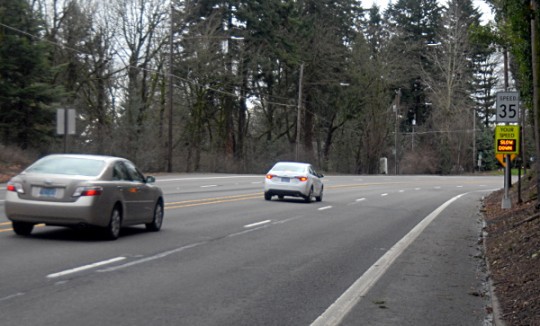This post is part of our SW Portland Week.
Here’s a confession: though I’ve driven on Southwest Barbur, ridden the bus on it, and walked along it to reach a vigil for a woman killed while she crossed it, in four years of reporting on the street and its problems I’ve never actually ridden a bike on it.
Until this week.
During the summer, somewhere between 250 and 500 people per weekday use Barbur Boulevard to bike back and forth between the heart of Southwest Portland and the rest of the city. It’s not the only way to get in and out of Southwest, which is home to about 65,000 people within the city limits. But it’s the flattest and most direct. Also, it’s the way I usually get to Southwest by car or bus, so if I didn’t know anything else about the route it’s the way I’d naturally try first.
Furthermore, as you can see above, it’s pretty well-marked from downtown. So midday Tuesday I decided to ride it and see what I could learn. I headed down the Transit Mall until 5th Avenue became Barbur and followed the big arrow above. Here’s what I saw first:
Since there was nothing prompting me to turn right here, I didn’t. Only after getting across the next street did I realize that despite the arrow pointing left onto the sidewalk, I was supposed to have turned right and used the bike signal to cross the street. But thanks to the big highway sign pointing to Barbur, I realized what I was supposed to do. Easy enough after the first time.
Here’s the next corner:
As I waited behind these two buses — with so many wide highway-style lanes and onramps nearby, I didn’t feel comfortable pulling around them — another came up behind me. I stopped to take a picture of this bus stop from the side:
After I crossed Southwest Broadway (which is also U.S. highway 26), I rode in Barbur’s wide bike lane, probably about six feet. Parts were in the door zone of some street parking, but it seemed little-used so not particularly uncomfortable. Further south, it became curb-tight, which was downright nice. Here’s a shot from about a mile south, approaching the mostly undeveloped section of Barbur that I’ve recently been hearing people refer to as the “Barbur Woods”:
Another half-mile south, I got to the one “intersection” in the woods: the overpass of Capitol Highway.
There’s a fairly steady stream of cars moving smoothly into this right-turn lane. Two did so as I approached, and the second didn’t bother with a turn signal. After that I glanced behind me; despite the green paint and the sign telling people driving to yield to me, I would have yielded to them if there hadn’t been a break in traffic.
Across the intersection, I pulled over to take a picture of this bus stop:
Next came the hardest part of riding Barbur, and the focus of most of our coverage of the street for years: the two bridges, slightly narrower than the rest of the street, that don’t have room for bike lanes unless at least one of the general travel lanes were removed. So the bike lanes go away.
Advertisement
Last year, the Oregon Department of Transportation scraped the pavement off these bridges and repaved it. Though the agency decided not to restripe the street, warning that doing so might lead to significantly slower auto traffic in 2035, it did add asphalt ramps up to the 3.1-foot wide maintenance walkway.
With the bike lane merging into a 45-mph general travel lane, my first instinct was to ride up the ramp, which I was pleased to find was comfortable and smooth. But once I was on the walkway I reconsidered whether it was actually safer. Here’s a sense of its width:
I decided I was better off taking the lane to my left. So I waited for another traffic break and swung back into the street, taking the middle of the travel lane across the bridge. I also did this on the second, similar bridge, less than a mile to the south:
This fellow, who pedaled past a little while after I did, chose to hug the right side of the same lane.
I’d heard that although few people would ever linger on Barbur today, the southern bridge offers a particularly nice view of the Willamette River and the city. Here it is:
South of the bridges, the posted speed limit falls from 45 mph to 35 mph. Just before the stoplight that ends the Barbur woods section, ODOT has installed an LED sign that detects and displays the speed of passers-by. I stopped in the bike lane, straddled my bike and pointed my camera at the sign as people passed me around this corner.
The sign seemed to give the actual speed for everything below 45 mph. Above 45 mph, it just switched to a faster flash of the words “Slow Down.”
Both of these cars got the faster flash:
Around this corner is the stoplight that signals the end of Barbur’s hairiest section and the beginning of its commercial area. Though this part of the road isn’t anybody’s idea of a biking paradise, it came as a relief.
Tomorrow, we’ll be taking a closer look at the progress and possibilities for improving the commercial stretch of Barbur.
Would the northern, wooded section of Barbur get easier to ride with a little practice? No doubt. The reason Portland’s bicycling advocates have been so adamant about improving the wooded section isn’t that it’s the worst place in the world to ride. The reason is that because of the nature of the street — no real intersections for two miles — the existence of passing lanes doesn’t actually increase the road’s capacity. They merely make it easier to speed. Because the traffic bottlenecks are the signals at north and south, restriping to add continuous bike lanes on this wooded stretch would have little effect on congestion.
I’ve heard many people say that this is a difficult concept to explain to the media and the public. I can only assume that most of those who think we shouldn’t bother trying have never ridden a bicycle in or out of Southwest Portland.
We’ll be here in Southwest all week. And join us Friday afternoon for a BikePortland Get Together and social hour at the Lucky Labrador Public House in Multnomah Village (7675 SW Capitol Hwy) from 4:00 – 6:30pm.


